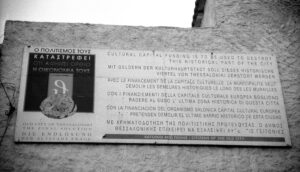A sign against the demolition of ‘kastroplikta’
Full Description
This is a sign posted next to the main gate (‘Portara’) in Ano Poli by residents of ‘kastroplikta’ against the demolition of their houses. These houses abut the city’s Byzantine walls and were built by refugees after 1922, becoming symbols of the identity, memories and character of Ano Poli. The houses were called ‘καστρόπληκτα’ (pronounced ‘kastroplikta’ which means ‘castle-stricken’, ‘the houses threatened by the walls’) as they were built directly adjacent to the Byzantine walls, with the walls sometimes constituting part of the dwelling’s structure. The push to demolish these houses targeted mainly the buildings on Eptapyrgiou Street and was prompted by Thessaloniki being awarded the title of European Capital of Culture for the year 1997, as the removal of ‘kastroplikta’ would better showcase the city’s Byzantine walls. This metal sign was placed on a building on the intersection of Akropoleos Street and Eptapyrgiou Street, next to the main gate. The spot was chosen for its central location, since it is on the route of a city bus, as well as the routes of tourist buses heading for the Tower of Trigonio and Yedi Kule. It is also opposite the Byzantine monastery Moni Vlatadon, which is a popular destination for the city’s religious tourists. The sign utilises the aesthetics, font and logo of the ‘Thessaloniki European Capital of Culture’ organisation in order to capture the attention of tourists and is written in six languages (English, German, French, Italian, Spanish, and Greek).
On closer inspection, however, it becomes clear that the designers of the sign have replaced the sailboat in the original logo of the Thessaloniki European Capital of Culture organisation with a bulldozer crushing the ‘kastroplikta’. In six different languages, the sign’s main message says: ‘FUNDED BY THE INSTITUTION OF THE EUROPEAN CULTURAL CAPITAL, THE MUNICIPALITY OF THESSALONIKI ATTEMPTS TO ELLIMINATE THESE NEIGHBOURHOODS’. Over the altered logo, the sign reads: ‘WHAT THEIR ECONOMY DOESN’T RUIN, THEIR CULTURE DOES’ and on the bottom left of the sign, in English and German, it says: ‘OLD CITY OF THESSALONIKI, THE FINAL SOLUTION’.
In the end, the demolition of ‘kastroplikta’ began in 1997, with the compensation of 65 property owners, but the process faced multiple delays and postponements until March 2009, almost 15 years later, when the Local Archaeological Council and the 9th Byzantine Antiquities Department approved the urban redevelopment plan submitted by the Municipality of Thessaloniki. The amended plan stipulated that of the remaining 32 buildings on Eptapyrgiou Street, 16 would be demolished and the other 16 would be preserved as monuments of refugee architecture. These buildings would be designated for non-residential use, specifically as cultural venues. Until autumn 2021, this redevelopment plan had not yet been fully realised.

